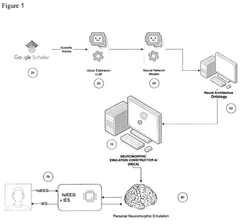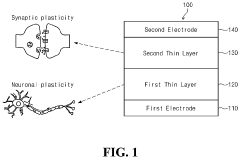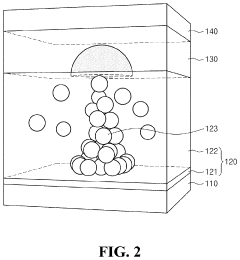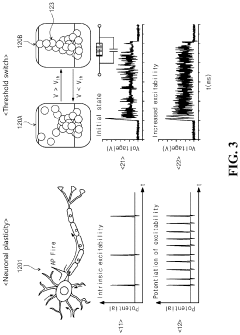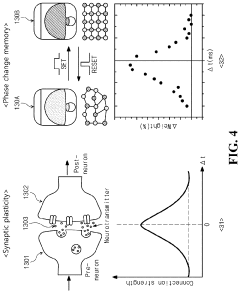Understanding neuromorphic materials in context of neural emulation
SEP 19, 20259 MIN READ
Generate Your Research Report Instantly with AI Agent
Patsnap Eureka helps you evaluate technical feasibility & market potential.
Neuromorphic Materials Evolution and Objectives
Neuromorphic computing represents a paradigm shift in computational architecture, drawing inspiration from the structure and function of biological neural systems. The evolution of neuromorphic materials has been marked by significant milestones since the concept was first introduced by Carver Mead in the late 1980s. Initially, neuromorphic systems relied on conventional silicon-based CMOS technology to mimic neural functions, with limited success in replicating the efficiency and adaptability of biological systems.
The field has progressed through several distinct phases, beginning with analog VLSI implementations that focused on mimicking basic neural functions. This was followed by the development of digital neuromorphic systems that offered greater programmability but still faced fundamental limitations in power efficiency and true neural emulation. The current era has witnessed a transition toward novel materials specifically engineered for neuromorphic applications.
Materials science breakthroughs have enabled significant advances in neuromorphic computing capabilities. Memristive materials, phase-change materials, spintronic devices, and organic electronics have emerged as promising candidates for building brain-inspired computing systems. These materials exhibit properties such as non-volatile memory, analog computation capability, and inherent plasticity that align closely with the requirements for neural emulation.
The primary objective of neuromorphic materials research is to develop substrates that can efficiently implement the key characteristics of biological neural systems: massive parallelism, co-location of memory and processing, adaptive learning, and ultra-low power consumption. Current silicon-based computing architectures face fundamental limitations in these areas, particularly regarding the von Neumann bottleneck that separates memory and processing units.
Recent developments have focused on materials that can implement synaptic plasticity mechanisms similar to those observed in biological systems, such as spike-timing-dependent plasticity (STDP). These materials enable the creation of artificial neural networks that can learn and adapt in real-time without explicit programming, similar to biological systems. The goal is to achieve computational systems that can process sensory information with the efficiency and adaptability of biological brains.
Looking forward, the field aims to develop neuromorphic materials and systems capable of supporting higher cognitive functions beyond simple pattern recognition. This includes working toward materials that can implement hierarchical processing, temporal dynamics, and context-dependent adaptation. The ultimate objective is to create computing systems that can approach the energy efficiency of the human brain, which operates on approximately 20 watts while performing complex cognitive tasks that still challenge the most advanced conventional computers consuming orders of magnitude more power.
The field has progressed through several distinct phases, beginning with analog VLSI implementations that focused on mimicking basic neural functions. This was followed by the development of digital neuromorphic systems that offered greater programmability but still faced fundamental limitations in power efficiency and true neural emulation. The current era has witnessed a transition toward novel materials specifically engineered for neuromorphic applications.
Materials science breakthroughs have enabled significant advances in neuromorphic computing capabilities. Memristive materials, phase-change materials, spintronic devices, and organic electronics have emerged as promising candidates for building brain-inspired computing systems. These materials exhibit properties such as non-volatile memory, analog computation capability, and inherent plasticity that align closely with the requirements for neural emulation.
The primary objective of neuromorphic materials research is to develop substrates that can efficiently implement the key characteristics of biological neural systems: massive parallelism, co-location of memory and processing, adaptive learning, and ultra-low power consumption. Current silicon-based computing architectures face fundamental limitations in these areas, particularly regarding the von Neumann bottleneck that separates memory and processing units.
Recent developments have focused on materials that can implement synaptic plasticity mechanisms similar to those observed in biological systems, such as spike-timing-dependent plasticity (STDP). These materials enable the creation of artificial neural networks that can learn and adapt in real-time without explicit programming, similar to biological systems. The goal is to achieve computational systems that can process sensory information with the efficiency and adaptability of biological brains.
Looking forward, the field aims to develop neuromorphic materials and systems capable of supporting higher cognitive functions beyond simple pattern recognition. This includes working toward materials that can implement hierarchical processing, temporal dynamics, and context-dependent adaptation. The ultimate objective is to create computing systems that can approach the energy efficiency of the human brain, which operates on approximately 20 watts while performing complex cognitive tasks that still challenge the most advanced conventional computers consuming orders of magnitude more power.
Market Analysis for Brain-Inspired Computing Solutions
The brain-inspired computing market is experiencing unprecedented growth, driven by the increasing demand for efficient processing of complex data patterns and the limitations of traditional von Neumann computing architectures. Current market valuations place neuromorphic computing at approximately $3.1 billion in 2023, with projections indicating a compound annual growth rate of 23.7% through 2030, potentially reaching $14.8 billion by the end of the decade.
Key market segments demonstrating significant demand include autonomous vehicles, where neuromorphic systems enable real-time decision-making with lower power consumption than conventional computing solutions. The healthcare sector represents another substantial market, with applications in medical imaging analysis, patient monitoring systems, and drug discovery processes that benefit from neural network-based pattern recognition.
Industrial automation and robotics constitute a rapidly expanding segment, with manufacturers seeking neuromorphic solutions to enhance machine vision, predictive maintenance, and adaptive control systems. Market research indicates that approximately 35% of industrial robotics companies are actively exploring or implementing neuromorphic computing technologies to improve operational efficiency.
The consumer electronics sector presents perhaps the largest potential market by volume, with neuromorphic chips increasingly integrated into smartphones, wearables, and smart home devices to enable edge AI capabilities while minimizing power consumption. This segment is expected to grow at 27.3% annually as device manufacturers compete to offer enhanced AI features without compromising battery life.
Geographically, North America currently leads the market with approximately 42% share, followed by Europe (28%) and Asia-Pacific (24%). However, the Asia-Pacific region is demonstrating the fastest growth rate at 29.1% annually, driven by substantial investments in AI infrastructure in China, Japan, and South Korea.
Market barriers include the relatively high cost of neuromorphic hardware development, limited standardization across platforms, and the need for specialized programming paradigms. Despite these challenges, venture capital investment in neuromorphic computing startups has increased by 156% since 2020, indicating strong confidence in market potential.
Customer adoption patterns reveal that organizations are initially implementing neuromorphic solutions for specific high-value applications rather than wholesale infrastructure replacement, creating a gradual but accelerating market penetration curve. Industry surveys indicate that 68% of Fortune 500 technology companies have neuromorphic computing initiatives in their three-year strategic roadmaps, signaling robust future demand.
Key market segments demonstrating significant demand include autonomous vehicles, where neuromorphic systems enable real-time decision-making with lower power consumption than conventional computing solutions. The healthcare sector represents another substantial market, with applications in medical imaging analysis, patient monitoring systems, and drug discovery processes that benefit from neural network-based pattern recognition.
Industrial automation and robotics constitute a rapidly expanding segment, with manufacturers seeking neuromorphic solutions to enhance machine vision, predictive maintenance, and adaptive control systems. Market research indicates that approximately 35% of industrial robotics companies are actively exploring or implementing neuromorphic computing technologies to improve operational efficiency.
The consumer electronics sector presents perhaps the largest potential market by volume, with neuromorphic chips increasingly integrated into smartphones, wearables, and smart home devices to enable edge AI capabilities while minimizing power consumption. This segment is expected to grow at 27.3% annually as device manufacturers compete to offer enhanced AI features without compromising battery life.
Geographically, North America currently leads the market with approximately 42% share, followed by Europe (28%) and Asia-Pacific (24%). However, the Asia-Pacific region is demonstrating the fastest growth rate at 29.1% annually, driven by substantial investments in AI infrastructure in China, Japan, and South Korea.
Market barriers include the relatively high cost of neuromorphic hardware development, limited standardization across platforms, and the need for specialized programming paradigms. Despite these challenges, venture capital investment in neuromorphic computing startups has increased by 156% since 2020, indicating strong confidence in market potential.
Customer adoption patterns reveal that organizations are initially implementing neuromorphic solutions for specific high-value applications rather than wholesale infrastructure replacement, creating a gradual but accelerating market penetration curve. Industry surveys indicate that 68% of Fortune 500 technology companies have neuromorphic computing initiatives in their three-year strategic roadmaps, signaling robust future demand.
Current Neuromorphic Materials Landscape and Barriers
The neuromorphic materials landscape is currently dominated by several key material categories, each with distinct properties and limitations. Memristive materials, including metal oxides like TiO2 and HfO2, represent a significant portion of research focus due to their ability to mimic synaptic plasticity through resistance changes. These materials demonstrate promising characteristics for spike-timing-dependent plasticity (STDP) implementation but face challenges in long-term stability and reproducibility across manufacturing processes.
Phase-change materials (PCMs), particularly chalcogenide compounds like Ge2Sb2Te5, offer excellent scalability and multi-level resistance states that enable analog computation. However, their high energy consumption during the crystallization process and thermal crosstalk between adjacent devices remain significant barriers to large-scale integration in neuromorphic systems.
Ferroelectric materials, including hafnium oxide derivatives and organic ferroelectrics, have emerged as promising candidates due to their non-volatile properties and low power consumption. The primary challenges include fatigue effects after repeated switching cycles and difficulties in controlling domain wall dynamics at nanoscale dimensions.
Magnetic materials, particularly those exhibiting spin-transfer torque effects, demonstrate exceptional endurance and switching speed. Their integration with CMOS technology, however, presents complex fabrication challenges and issues with thermal stability at reduced dimensions, limiting their immediate application in commercial neuromorphic systems.
Two-dimensional materials like graphene and transition metal dichalcogenides represent the cutting edge of neuromorphic materials research, offering unprecedented flexibility and potential for ultra-low power operation. The field faces significant barriers in developing reliable manufacturing processes that maintain consistent electrical properties across large areas.
Biological and organic materials present perhaps the most radical approach, with proteins, peptides, and conducting polymers showing promise for biocompatible neural interfaces. These materials suffer from limited stability in non-biological environments and significant variability in performance characteristics.
Cross-cutting challenges across all material platforms include achieving sufficient uniformity for large-scale arrays, managing device-to-device variability, and developing appropriate peripheral circuitry that can effectively interface with these novel materials. Additionally, the lack of standardized benchmarking protocols makes direct comparison between different material systems difficult, hampering systematic progress in the field.
The geographical distribution of neuromorphic materials research shows concentration in North America, Europe, and East Asia, with significant contributions from academic institutions and industry research labs in the United States, Germany, China, Japan, and South Korea.
Phase-change materials (PCMs), particularly chalcogenide compounds like Ge2Sb2Te5, offer excellent scalability and multi-level resistance states that enable analog computation. However, their high energy consumption during the crystallization process and thermal crosstalk between adjacent devices remain significant barriers to large-scale integration in neuromorphic systems.
Ferroelectric materials, including hafnium oxide derivatives and organic ferroelectrics, have emerged as promising candidates due to their non-volatile properties and low power consumption. The primary challenges include fatigue effects after repeated switching cycles and difficulties in controlling domain wall dynamics at nanoscale dimensions.
Magnetic materials, particularly those exhibiting spin-transfer torque effects, demonstrate exceptional endurance and switching speed. Their integration with CMOS technology, however, presents complex fabrication challenges and issues with thermal stability at reduced dimensions, limiting their immediate application in commercial neuromorphic systems.
Two-dimensional materials like graphene and transition metal dichalcogenides represent the cutting edge of neuromorphic materials research, offering unprecedented flexibility and potential for ultra-low power operation. The field faces significant barriers in developing reliable manufacturing processes that maintain consistent electrical properties across large areas.
Biological and organic materials present perhaps the most radical approach, with proteins, peptides, and conducting polymers showing promise for biocompatible neural interfaces. These materials suffer from limited stability in non-biological environments and significant variability in performance characteristics.
Cross-cutting challenges across all material platforms include achieving sufficient uniformity for large-scale arrays, managing device-to-device variability, and developing appropriate peripheral circuitry that can effectively interface with these novel materials. Additionally, the lack of standardized benchmarking protocols makes direct comparison between different material systems difficult, hampering systematic progress in the field.
The geographical distribution of neuromorphic materials research shows concentration in North America, Europe, and East Asia, with significant contributions from academic institutions and industry research labs in the United States, Germany, China, Japan, and South Korea.
Contemporary Neuromorphic Material Implementation Approaches
01 Memristive materials for neuromorphic computing
Memristive materials are used to create artificial synapses and neurons for neuromorphic computing systems. These materials can change their resistance based on the history of applied voltage or current, mimicking the behavior of biological synapses. This property allows for the implementation of learning algorithms and memory functions in hardware, enabling more efficient neural emulation compared to traditional computing architectures.- Memristive materials for neuromorphic computing: Memristive materials are used to create artificial synapses and neurons that mimic the behavior of biological neural systems. These materials can change their resistance based on the history of applied voltage or current, enabling them to store and process information simultaneously. This property makes them ideal for implementing neuromorphic architectures that can perform brain-like computations with high energy efficiency and parallel processing capabilities.
- Phase-change materials for neural emulation: Phase-change materials can rapidly switch between amorphous and crystalline states, exhibiting different electrical properties in each state. This characteristic allows them to function as artificial neurons and synapses in neuromorphic systems. These materials enable spike-timing-dependent plasticity and other neural learning mechanisms, making them suitable for implementing neural networks that can adapt and learn from input patterns similar to biological neural systems.
- 2D materials for neuromorphic applications: Two-dimensional materials such as graphene, transition metal dichalcogenides, and hexagonal boron nitride offer unique electronic properties that make them promising candidates for neuromorphic computing. Their atomically thin structure allows for efficient charge transport and tunable electronic properties. These materials can be engineered to exhibit synaptic behaviors like potentiation, depression, and spike-timing-dependent plasticity, enabling the development of highly efficient and compact neuromorphic devices.
- Organic and polymer-based neuromorphic materials: Organic and polymer-based materials offer flexibility, biocompatibility, and low-cost fabrication for neuromorphic systems. These materials can be engineered to exhibit synaptic behaviors through mechanisms such as ion migration, conformational changes, or charge trapping. Their soft nature makes them particularly suitable for bio-interfacing applications and flexible electronics that can interact with biological neural systems, potentially enabling direct brain-machine interfaces.
- Quantum materials for advanced neural emulation: Quantum materials leverage quantum mechanical effects to implement neuromorphic functionalities beyond classical limitations. These materials exhibit properties such as quantum tunneling, superposition, and entanglement that can be harnessed for neural computation. Quantum neuromorphic systems can potentially solve complex problems more efficiently than classical approaches, particularly for applications requiring massive parallelism and probabilistic computing, such as pattern recognition and optimization problems.
02 Phase-change materials for neural networks
Phase-change materials exhibit properties that can be utilized for implementing neuromorphic computing elements. These materials can switch between amorphous and crystalline states, providing different electrical resistances that can be used to store and process information. By controlling the phase transitions, these materials can emulate synaptic plasticity and learning behaviors, making them suitable for hardware implementation of neural networks with low power consumption.Expand Specific Solutions03 Spintronic devices for brain-inspired computing
Spintronic devices utilize the spin of electrons rather than their charge for information processing, offering advantages for neuromorphic computing. These devices can emulate neural functions with high energy efficiency and density. Magnetic materials and structures such as magnetic tunnel junctions can be engineered to mimic synaptic behavior, enabling the development of brain-inspired computing architectures that perform neural emulation with significantly reduced power consumption compared to conventional electronic systems.Expand Specific Solutions04 2D materials for neuromorphic applications
Two-dimensional materials such as graphene, transition metal dichalcogenides, and hexagonal boron nitride offer unique properties for neuromorphic computing. Their atomic-scale thickness, tunable electronic properties, and compatibility with existing fabrication technologies make them promising candidates for building artificial neural networks. These materials can be used to create ultra-thin synaptic devices with analog switching behavior, facilitating the development of compact and energy-efficient neuromorphic systems.Expand Specific Solutions05 Organic and biomimetic materials for neural emulation
Organic and biomimetic materials offer a more biologically realistic approach to neural emulation. These materials can include conducting polymers, protein-based structures, and hybrid organic-inorganic composites that mimic the functionality of biological neurons and synapses. Their flexibility, biocompatibility, and self-organizing properties enable the development of neuromorphic systems that more closely resemble biological neural networks in both structure and function, potentially leading to more efficient learning and adaptation capabilities.Expand Specific Solutions
Leading Organizations in Neuromorphic Computing Research
Neuromorphic materials for neural emulation are at an early growth stage, with the market expanding rapidly due to increasing applications in AI and brain-inspired computing. The global market is projected to reach significant scale as major players invest in research and commercialization. Technology maturity varies, with companies like IBM, Samsung, and SK hynix leading in hardware implementations, while academic institutions such as KAIST and Peking University focus on fundamental research. Industry leaders including Adobe and Siemens are exploring applications, while specialized research organizations like Howard Hughes Medical Institute and government entities contribute to foundational science. The ecosystem shows a balanced mix of commercial development and academic innovation, indicating a technology approaching inflection point toward broader adoption.
Samsung Electronics Co., Ltd.
Technical Solution: Samsung has developed advanced neuromorphic materials and architectures focusing on memory-centric computing paradigms. Their approach leverages their expertise in memory technologies, particularly resistive RAM (RRAM) and magnetoresistive RAM (MRAM), to create brain-inspired computing systems. Samsung's neuromorphic research includes high-density crossbar arrays of memristive devices that can efficiently implement neural network operations. Their technology demonstrates synaptic behaviors including potentiation, depression, and spike-timing-dependent plasticity. Samsung has reported neuromorphic chips capable of performing pattern recognition tasks with significantly reduced power consumption compared to conventional architectures[3]. Their neuromorphic materials research extends to 3D stacking technologies that increase neural density while maintaining energy efficiency. Samsung has also explored the integration of neuromorphic elements with conventional CMOS technology to create hybrid systems that combine the strengths of both approaches[4].
Strengths: Vertical integration capabilities from materials to systems; extensive manufacturing expertise; strong position in memory technologies that form the foundation of many neuromorphic approaches; ability to scale production. Weaknesses: Less public research output compared to academic institutions; commercial focus may limit exploration of more experimental approaches; challenges in transitioning from memory-focused to computing-focused architectures.
International Business Machines Corp.
Technical Solution: IBM has pioneered neuromorphic computing through its TrueNorth and subsequent neuromorphic chip architectures. Their approach focuses on creating brain-inspired hardware that mimics neural structures and functions. IBM's neuromorphic materials research includes phase-change memory (PCM) elements that can emulate synaptic plasticity. Their TrueNorth chip contains 5.4 billion transistors organized into 4,096 neurosynaptic cores, with 1 million programmable neurons and 256 million configurable synapses[1]. IBM has further developed their neuromorphic technology with materials that can simultaneously process and store information, similar to biological neurons. Their research includes specialized memristive devices that can implement spike-timing-dependent plasticity (STDP) learning rules directly in hardware. IBM has also explored three-dimensional integration of neuromorphic materials to increase neural density and connectivity, more closely approximating biological neural architectures[2].
Strengths: Industry-leading expertise in neuromorphic hardware design; extensive research infrastructure; integration capabilities with traditional computing systems; proven energy efficiency (TrueNorth operates at 70mW, orders of magnitude more efficient than conventional processors). Weaknesses: Complex programming model requires specialized knowledge; limited commercial deployment of neuromorphic technologies; challenges in scaling to human-brain levels of complexity.
Critical Patents and Breakthroughs in Neural Emulation Materials
Neuromorphic Emulation Constructor AI for Precise Computational Emulation of Human Brain Architecture
PatentPendingUS20250021807A1
Innovation
- The Neuromorphic Emulation Constructor AI (NECA) constructs precise computational models of an individual's brain by leveraging scientific literature, continuous high-definition electroencephalography (hdEEG) monitoring, and neuromorphic quantum computing, incorporating Bayesian super-resolution for enhanced accuracy, and is assisted by the Neuromorphic Artificial Neural Network Assistant (NANNA) for data collection and training.
Neuromorphic memory element simultaneously implementing volatile and non-volatile feature for emulation of neuron and synapse
PatentPendingUS20240008292A1
Innovation
- A neuromorphic memory element is developed, combining volatile and non-volatile features in a single element to emulate neurons and synapses, utilizing a threshold switching portion and a phase change memory portion with specific materials like silver-doped silicon dioxide and GST or AIST materials, respectively, to enable efficient energy use and parallel operation.
Energy Efficiency Considerations in Neuromorphic Systems
Energy efficiency represents a critical consideration in the development and implementation of neuromorphic systems. Traditional von Neumann computing architectures face significant energy constraints when simulating neural networks, consuming orders of magnitude more power than the human brain for comparable computational tasks. The human brain operates on approximately 20 watts of power while performing complex cognitive functions, whereas conventional computing systems may require kilowatts to simulate similar neural processes.
Neuromorphic materials offer promising pathways to dramatically reduce energy consumption through their inherent physical properties. Materials such as memristors, phase-change memory (PCM), and spin-based devices enable in-memory computing paradigms that eliminate the energy-intensive data transfer between memory and processing units characteristic of conventional architectures. These materials can maintain states with minimal or no power consumption, allowing for persistent computation without continuous energy input.
Recent advancements in neuromorphic hardware have demonstrated remarkable efficiency gains. IBM's TrueNorth chip achieves approximately 400 million synaptic operations per second per watt, while Intel's Loihi neuromorphic research chip demonstrates 1,000 times better energy efficiency than general-purpose computing systems for certain neural workloads. SpiNNaker systems have similarly shown substantial energy advantages for spiking neural network implementations.
The energy efficiency of neuromorphic systems stems from several fundamental design principles. First, event-driven computation allows the system to consume energy only when information processing is necessary, rather than during continuous clock cycles. Second, co-location of memory and processing eliminates the energy costs associated with data movement. Third, parallel processing architectures distribute computational loads across numerous simple processing elements rather than relying on fewer complex, high-power processors.
Challenges remain in optimizing energy consumption across different operational modes. Static power leakage during idle states represents a significant concern, particularly for large-scale neuromorphic implementations. Additionally, the energy required for learning and adaptation processes often exceeds that needed for inference operations, necessitating careful system design to balance these requirements.
Future directions in energy-efficient neuromorphic computing include exploration of novel materials with ultra-low switching energies, optimization of neural coding schemes to maximize information transfer while minimizing spike events, and development of hybrid systems that dynamically allocate computational resources based on task requirements and energy constraints.
Neuromorphic materials offer promising pathways to dramatically reduce energy consumption through their inherent physical properties. Materials such as memristors, phase-change memory (PCM), and spin-based devices enable in-memory computing paradigms that eliminate the energy-intensive data transfer between memory and processing units characteristic of conventional architectures. These materials can maintain states with minimal or no power consumption, allowing for persistent computation without continuous energy input.
Recent advancements in neuromorphic hardware have demonstrated remarkable efficiency gains. IBM's TrueNorth chip achieves approximately 400 million synaptic operations per second per watt, while Intel's Loihi neuromorphic research chip demonstrates 1,000 times better energy efficiency than general-purpose computing systems for certain neural workloads. SpiNNaker systems have similarly shown substantial energy advantages for spiking neural network implementations.
The energy efficiency of neuromorphic systems stems from several fundamental design principles. First, event-driven computation allows the system to consume energy only when information processing is necessary, rather than during continuous clock cycles. Second, co-location of memory and processing eliminates the energy costs associated with data movement. Third, parallel processing architectures distribute computational loads across numerous simple processing elements rather than relying on fewer complex, high-power processors.
Challenges remain in optimizing energy consumption across different operational modes. Static power leakage during idle states represents a significant concern, particularly for large-scale neuromorphic implementations. Additionally, the energy required for learning and adaptation processes often exceeds that needed for inference operations, necessitating careful system design to balance these requirements.
Future directions in energy-efficient neuromorphic computing include exploration of novel materials with ultra-low switching energies, optimization of neural coding schemes to maximize information transfer while minimizing spike events, and development of hybrid systems that dynamically allocate computational resources based on task requirements and energy constraints.
Ethical Implications of Brain-Inspired Computing Technologies
The rapid advancement of neuromorphic materials and brain-inspired computing technologies raises profound ethical questions that society must address. These technologies, which aim to emulate neural functions through specialized materials and architectures, blur the traditional boundaries between artificial systems and biological cognition, creating unprecedented ethical challenges.
Privacy concerns emerge as neuromorphic systems potentially gain the ability to process and interpret personal data in ways that mimic human cognition. Unlike conventional computing systems, these technologies may develop capabilities to recognize patterns in human behavior and make inferences about individuals that extend beyond explicit programming, raising questions about informed consent and data ownership in this new paradigm.
The development of increasingly sophisticated neural emulation raises fundamental questions about machine consciousness and moral status. As neuromorphic systems approach more accurate representations of neural processes, society must confront whether these systems might eventually develop forms of experience or awareness that deserve ethical consideration. This philosophical frontier challenges our traditional anthropocentric ethical frameworks.
Neuromorphic technologies also present significant implications for human autonomy and decision-making. As these systems become integrated into critical infrastructure, healthcare, and governance, questions arise about appropriate human oversight and the potential delegation of morally significant decisions to brain-inspired computing systems that may operate through processes not fully transparent to human understanding.
Socioeconomic concerns cannot be overlooked, as neuromorphic computing may accelerate automation in ways that traditional computing could not. The potential displacement of cognitive labor through systems that can adapt and learn in neuromorphic ways presents challenges for workforce transition and economic stability that require proactive policy approaches.
Dual-use concerns are particularly acute with neuromorphic technologies, as systems designed to emulate neural processes could potentially be repurposed for surveillance, manipulation of human behavior, or autonomous weapons systems with unprecedented capabilities. International governance frameworks must evolve to address these emerging risks.
Finally, neuromorphic technologies raise questions about human identity and exceptionalism. As machines begin to process information in ways inspired by human cognition, society must reconsider what capabilities remain uniquely human and how we define ourselves in relation to increasingly sophisticated artificial systems that mirror aspects of our neural architecture.
Privacy concerns emerge as neuromorphic systems potentially gain the ability to process and interpret personal data in ways that mimic human cognition. Unlike conventional computing systems, these technologies may develop capabilities to recognize patterns in human behavior and make inferences about individuals that extend beyond explicit programming, raising questions about informed consent and data ownership in this new paradigm.
The development of increasingly sophisticated neural emulation raises fundamental questions about machine consciousness and moral status. As neuromorphic systems approach more accurate representations of neural processes, society must confront whether these systems might eventually develop forms of experience or awareness that deserve ethical consideration. This philosophical frontier challenges our traditional anthropocentric ethical frameworks.
Neuromorphic technologies also present significant implications for human autonomy and decision-making. As these systems become integrated into critical infrastructure, healthcare, and governance, questions arise about appropriate human oversight and the potential delegation of morally significant decisions to brain-inspired computing systems that may operate through processes not fully transparent to human understanding.
Socioeconomic concerns cannot be overlooked, as neuromorphic computing may accelerate automation in ways that traditional computing could not. The potential displacement of cognitive labor through systems that can adapt and learn in neuromorphic ways presents challenges for workforce transition and economic stability that require proactive policy approaches.
Dual-use concerns are particularly acute with neuromorphic technologies, as systems designed to emulate neural processes could potentially be repurposed for surveillance, manipulation of human behavior, or autonomous weapons systems with unprecedented capabilities. International governance frameworks must evolve to address these emerging risks.
Finally, neuromorphic technologies raise questions about human identity and exceptionalism. As machines begin to process information in ways inspired by human cognition, society must reconsider what capabilities remain uniquely human and how we define ourselves in relation to increasingly sophisticated artificial systems that mirror aspects of our neural architecture.
Unlock deeper insights with Patsnap Eureka Quick Research — get a full tech report to explore trends and direct your research. Try now!
Generate Your Research Report Instantly with AI Agent
Supercharge your innovation with Patsnap Eureka AI Agent Platform!
